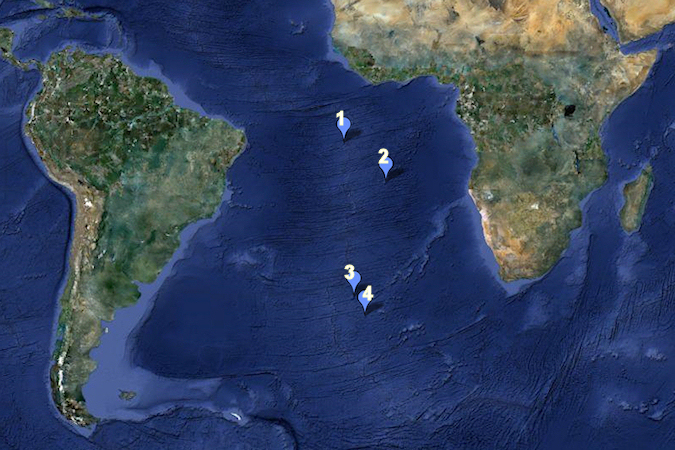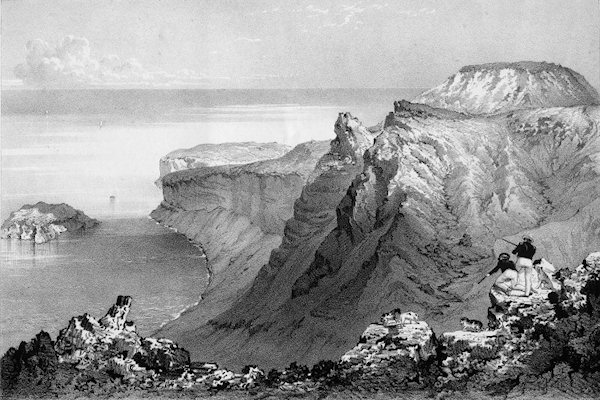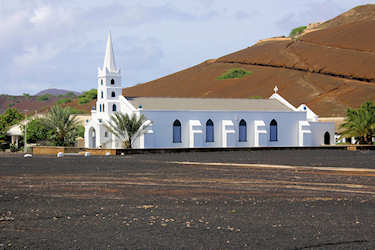Mid Atlantic Islands

Historie
1) Ascension Island
Ascension was discovered in 1501 by the Portuguese seafarer Jošo da Nova, who named it
Conception. Not until two years later on Ascension Day 1503, was the island officially claimed and
named by Alphonso d'Alburquerque.
During the 17th century, ships started to call at the island to supply themselves with turtle meat and eggs
to supplement their shipboard diet. In return they would leave goats behind for ships which called at the
island after them. This practice continued into the 19th century. This seemed to be one of the main reasons
for ships stopping here, but also there were occaisions where a wrongdoer would be marooned on the island as
punishment for his crimes.
The fact that it was dry and barren was most likely the reason that Ascension remained uninhabited until
Napoleonwas sent to St Helena in exile in 1815. During the former emperor's captivity on St Helena,
a small British naval garrison was stationed on Ascension to deter any attempt at rescue.
2) St Helena
On 21 may 1502, the Portugese admiral Jošo da Nova, who was returning from the west coast of India, came upon an undiscovered island. The day of its discovery was the anniversary of St Helena, the mother of Emperor Constantine. In honour off her, he called the island Santa Helena and claimed it in the name of the King of Portugal.
 |
|||||
The Portuguese soon realised the significance of the location of this island, between Cape of Good Hope
and Cape Verde. it would serve them well as a calling point to replenish the supplies of ships sailing
home from the east. The island was also used to offload sick crew members; if they survived, they were taken
back on the ships upon their return to the island. despite all this movement, the Portugese were able to keep
the existence of the island secret for over 80 years.
On 8 june 1588 the English explorer, Thomas Cavendish landed on the island, while on the last stage of
his voyage around teh world. The island was now no longer a Portugese secret. In 1592 King Philip II
of Spain and Portugal warned his fleet not to stop at St Helene on their return from Goa, because since
Cavendish's discovery, English captains had learned of the heavily laden Portuguese ships returning from
India and were lying in wait to attack them on their way home.
The Dutch Republic formally made claim to St Helena in 1633, although there is no evidence that they
ever occupied, colonised or fortified it. By 1651, the Dutch had mainly abandoned the island in favour of
their colony at the Cape of Good Hope.
In 1657, Oliver Cromwell granted the English East India Company a charter to govern St Helena and the
following year the Company decided to fortify the island and colonise it with planters.
In 1815 the British government selected Saint Helena as the place of detention of Napoleon Bonaparte.
He was brought to the island in October 1815 and lodged at Longwood, where he died on 5 May 1821.
3) Tristan da Cuhna
The islands were first sighted in 1506 by Portuguese explorer Trist„o da Cunha, although rough seas
prevented a landing. He named the main island after himself, Ilha de Trist„o da Cunha, which was later
anglicised to Tristan da Cunha Island.
The island then vecame well known to navigators after the Dutch East India Company instructed its
commanders to use the longer but quicker route from Europe to the Cape of Good Hope (via West Indies - Brazil
- Tristan) to take advantage of prevailing winds and currents.
In 1816 the United Kingdom formally annexed the islands, ruling them from the Cape Colony in South Africa. This
is reported to have primarily been a measure to ensure that the French would not be able to use the islands as
a base for a rescue operation to free Napoleon Bonaparte from his prison on Saint Helena. The occupation
also prevented the United States from using Tristan da Cunha as a base, as they had during the War of 1812
The islands were occupied by a garrison of British Marines, and a civilian population was gradually built up.
Whalers also set up on the islands as a base for operations in the Southern Atlantic. However, the opening of
the Suez Canal in 1869, together with the gradual move from sailing ships to coal-fired steam ships, increased
the isolation of the islands, as they were no longer needed as a stopping port for journeys from Europe to
the Far East.
4) Gough Island
Gough Island was discovered in the early 16th Century by the Portuguese navigator, Goncalo Alvarez,
who gave it his name: the island was commonly known as Diego Alvarez.
According to some historians, the English merchant Anthony de la Rochť was the first to land on the
island, in April 1675.
Little was heard of the island subsequently, until it was resighted by Captain Gough of the Richmond,
a British ship, in 1731. Its precise geographical location was unclear for many years, but eventually it
became known to British and American sealers and whalers, who preferred the name Gough.
I visited the Mid Atlantic Islands in april 2011.
(It was part of the Atlantic Odessey)
On that trip i have seen
Ascension Island
St Helena
Tristan da Cuhna
Gough Island
Please let me know when you're having questions.
i would be pleased to help you.
Things to do and other tips
